Which Hand Dryer Is Best?

Not all commercial hand dryers are created equal, so selecting new hand dryers can be a somewhat complex affair. However, while hand dryers vary in design, efficiency, power output and price, it’s crucial to establish what’s most important to you.
For instance, if you are looking for low energy efficiency, you can immediately narrow your search. Likewise, if you have a strict budget set in place then your options are also going to be more refined. Of course, the most fundamental aspect of any hand dryer though is its ability to dry your hands.

Traditional style hand dryers
The hand dryer most users are familiar with has been the top-down hand dryer that blows hot air down onto hands. These offer great usability, but can sometimes take longer to dry wet hands when compared to modern, high-speed hand dryers. However, there are fast-dry options available that can also come in at a very reasonable price point.
Sensor hand dryers
Sensor activation is one of the most powerful improvements brought to hand dryers. As well as being easier and more intuitive to operate, they also remove the need for a user to physically touch the unit. This significantly improves hygiene in your washroom and also prevents heavy-handed use and premature wear and tear. Sensor activation is available across almost all hand dryer types.

Blade hand dryers
Dyson might be the most well known and highly regarded manufacturer of blade style hand dryers, but they are not the only brand to deliver these high-quality units in the market. Mitsubishi and Biodrier are also well-respected players in this field. Blade driers use a different type of technology compared to the hand dryers of old. Instead of blowing hot air over a users hands, which requires a heating element, blade driers produce a stream of high-pressure air which physically blows all the moisture off and away from the hands. Initially, most blade style hand dryers were designed where users lowered their hands into the unit. However, you can now get blade driers in various shapes and sizes, including those that work simultaneously through the arms of a sensor tap, such as the Dyson Airblade Wash + Dry.
Eco hand dryers
With concerns over both climate and the bottom line, many organisations are looking to employ low energy improvements wherever possible. In this instance, most blade style or high-pressure hand dryers are going to win out, mainly because they don't require a heating element. Heating elements require more energy to heat up the airflow in a short space of time.
So how do you choose the right hand dryer?
For ultimate efficiency, hand drying speed and hygiene, it’s hard to ignore blade style hand dryers, which come across a number of designs and price points. However, it’s also important not to overlook traditional top-down models too. Ultimately, you need to weigh your budget against your priorities of hygiene and efficiency. In light of the 2020 coronavirus pandemic though, we would suggest sensor activation wherever possible.
If you would like further advice on hand dryers, or for anything else commercial washroom related, please get in touch with one fo the team on 01202 650900.
MORE TO EXPLORE IN Related Posts

Fast Dry Hand Dryer Stainless Steel

Dyson Airblade Wash+Dry Hand Dryer

Biodrier Business² High Speed Hands In Dryer






